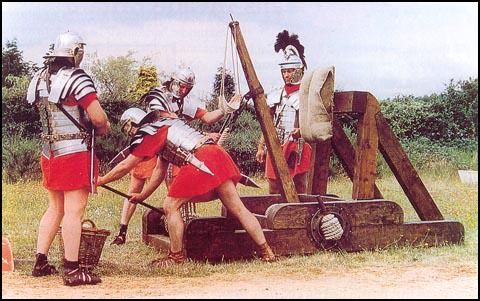Roman Soldiers
Roman soldiers wore a linen undergarment. Over this they wore a short-sleeved, knee-length woollen tunic. Romans originally believed that it was effeminate to wear trousers. However, as their empire expanded into territories with colder climates, soldiers were allowed to wear leather, skin-tight trousers.
Roman soldiers wore armour made of metal strips. These strips were hinged and laced together to allow for the maximum amount of movement during battle. Round his neck, the legionary wore a scarf to protect his skin from the metal armour.
At first Roman soldiers wore bronze helmets. However, they did not provide adequate protection against the swords used by the barbarians, and they were replaced by helmets made of iron.
The shield that the soldier carried was made of thin strips of wood glued together. To give it extra strength, the grain of each strip was at right angles to the piece next to it. The surface of the shield was made of iron or bronze. After losing several battles to the barbarians, the Romans altered the size and shape of the shield to give the body more protection.
The officers wore cloaks to distinguish them from ordinary soldiers. The colour of the cloak would depend on their rank.

The legionary was armed with a javelin (pilum) and a short sword (gladius). The pilum was about 2 metres long and had a killing range of about 35 metres. The pilum also weighed down the shields of the defending army and therefore made them virtually useless. The thin metal shaft of the pilum buckled on impact so it could not be thrown back at the Romans.
After throwing their javelins the legionnaires would rush forward and fight with their double-bladed swords. In battle, the sword was used like a bayonet.
The most valued item in the Roman army was the regimental standard. Made of gold or silver, the standard, with its eagle head, would be used to direct an attack on the enemy. The person who held the standard wore animal skins over his uniform. To lose your standard in battle would mean permanent disgrace for the regiment.
1. Explain why archaeologists have discovered a large number of Roman weapons but only one
regimental standard.
2. Why did the Romans change the helmets and shields used by their army?
3. Study the photograph of the Roman soldiers. What does this source tell us about Roman uniforms? Why would it be important to look at other sources before reaching any conclusions about Roman uniforms?
